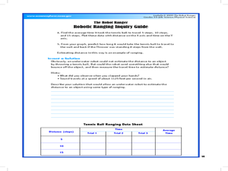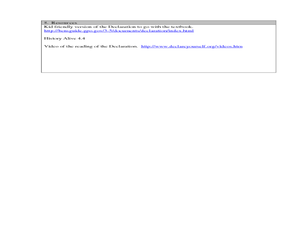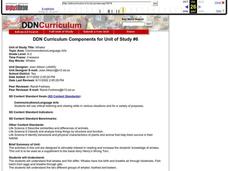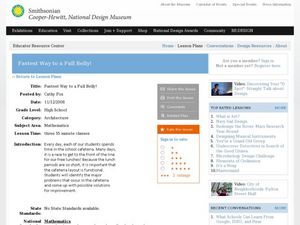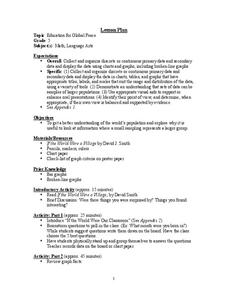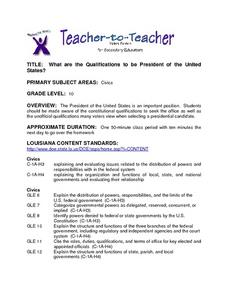Curated OER
Solar Oven
Sixth graders design two different solar ovens to learn about heat transfer. They investigate the movement of heat between objects by conduction, convection, and radiation. They become aware of things they can't control, like the...
Curated OER
The Cay: Creatures of the Coral Reef
Students make a connection between science and literature. After reading the first five chapters of the novel The Cay, they describe the physical characteristics of a coral reef, as well as describe and distinguish between the many...
Curated OER
Get On Board
Students create a ticket table illustrating the cost of tickets by alternative transportation. In this number sense lesson, students write number sentences to compare and contrast difference information in their chart. Students figure...
Curated OER
Alice Computer Programming
Students explore multimedia components. In this science inquiry lesson, students read "Invitation to the Game" by Monica Hughes and they use the Alice Computer Programming System to better understand population dynamics.
Curated OER
Biomimicry, Nature: Architecture of the Future
Students explore the relationship between nature and architecture. In this cross curriculum history, culture, and architecture lesson, students observe and discuss structures visible in nature. Students view websites in which Native...
National Endowment for the Humanities
From Courage to Freedom
Learners analyze Frederick Douglass' narrative about Christianity and slavery. In this Frederick Douglass lesson, young scholars read his slave narrative and analyze its word choice, imagery, irony, and rhetorical appeals. Learners...
Curated OER
The Robot Ranger
Students participate in an experiment to understand how robotic systems can estimate distances. In this robotic ranger lesson, students measure the the time it takes for and object to move back and forth. Students will use a tennis...
Curated OER
Political and Cultural Road to the American Revolution
Learners examine the Declaration of Independence. For this Revolutionary War instructional activity, young scholars use primary sources to analyze how the creation of the Declaration of Independence lead to the development of the United...
Curated OER
Whales
Students compare the differences between whales and fish. They examine the differences of toothed and baleen whales. They identify behavioral and physical characteristics of animals that help them survive in their habitat.
Curated OER
Lewis and Clark in Washington Shrub Steppe Habitat
Students examine the land of the shrub steppe and compare it with Lewis and Clark's journals. They list the characteristics of the land. They also discuss restoration of native plants.
Curated OER
Social Studies Timeline
Third graders make a timeline for the information covered in their social studies textbook. They use Inspiration software to create a timeline that includes information from the social studies chapter.
Curated OER
The Starry Night Time and Day Time
Second graders complete a unit of lessons on the solar system. They complete various art projects inspired by Van Gogh's 'Starry Night,' create a moon phases book, create a moon phase wind chime, develop a timeline of space exploration,...
Curated OER
Time Signifiers - Past or Present Perfect?
Young scholars refine their usage of past simple or present perfect. After a lecture/demo, students work in pairs and utilize a worksheet imbedded in this plan to help them gain practice with time signifiers.
Curated OER
Identify Plant Nutrient Requirements
Young scholars are given standard elemental nutrients, identify plant nutrient requirements based on criteria outlined in assessment instructment. They, are given standard elemental nutrients, provide all means and chemical symbols of...
Curated OER
Fastest Way to a Full Belly
Students create a scale model of a cafeteria. In this scale lesson, groups improve their actual school cafeteria layout by taking measurements of the structure and redesigning furniture and food serving lines. They create a scale drawing...
Curated OER
Education for Global Peace
Fifth graders construct data graphs based upon sets of data. In this graphing instructional activity, 5th graders read the text If the World Were a Village and discuss how types of graphs accurately represent a large population. Students...
Curated OER
What are the Qualifications to be President of the United States?
Learners research the qualifications necessary to be the president of the United States. They create a want-ad for this position using what they have learned about the qualifications.
Curated OER
Archeology of the Future
Students are introduced to the basic vocabulary of archeology. Using the vocabulary, they classify artifacts and make inferences about their uses. In groups, they create a chart for the criteria needed to analyze artifacts and share...
Curated OER
Colonial Research Fun
Students review the characteristics of the thirteen colonies. In groups, they use the internet to research one of the colonies more in depth and answer questions about it. They develop a newspaper or travel brochure to share the...
Curated OER
Fraction Equivalence
Fourth graders explore fractions. They compare different fractions using fraction bars. Students find equivalent fractions and they use fraction bars to visualize addition of fractions.
Curated OER
Weathervanes in the Wind
Students investigate wind and weather by creating a weathervane. In this environment lesson, students identify the purpose of a weathervane and observe weathervanes in action on their campus. Students create a weathervane and decorate...
Curated OER
Christmas Celebrations
Second graders view a video of the Nutcracker ballet and then compare and contrast holiday celebrations in Germany and the United States. They use the computer to write a paragraph exploring their observations.
Curated OER
We the People (Cultural Research)
Fourth graders conduct cultural research, collect oral histories using tape recorders and cameras, and share their ancestral heritage with classmates through family heirlooms and ethnic foods.
Curated OER
American Deaf Culture: Deaf Art
Students examine the culture and art of the Deaf Community. They discover the history of the Deaf Community using art and their values. They compare and contrast different pieces of art.








